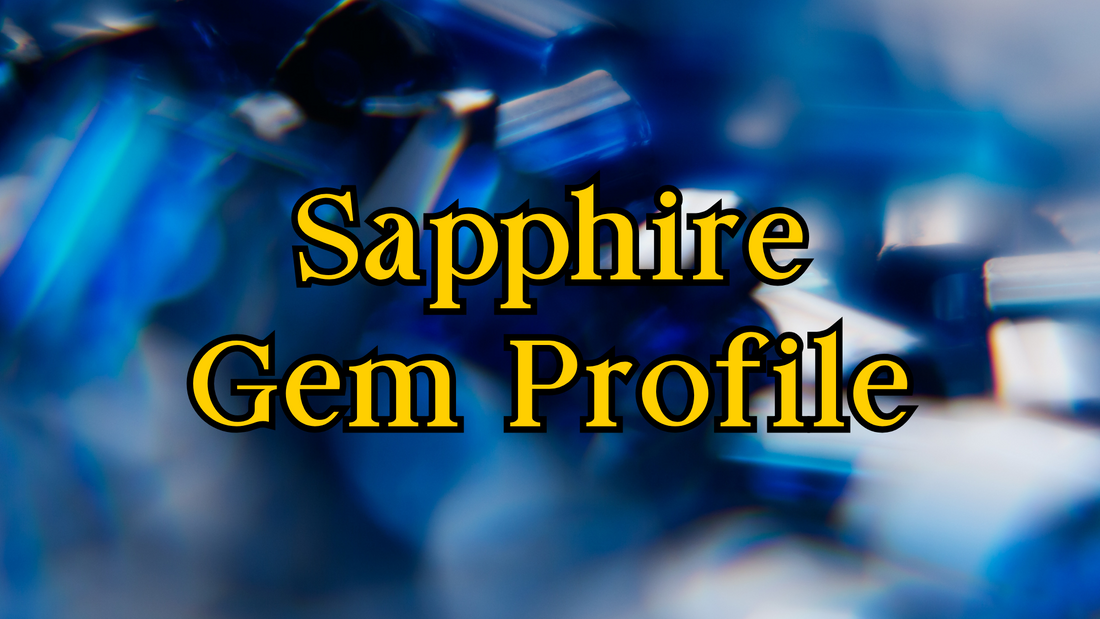
A Jeweller’s Guide to Sapphire: Identification Tips and Jewellery Making Advice
Prepare to be dazzled by sapphire, one of the gemstone worlds big 5. Known for its deep blue hues, this gemstone is more than just beautiful, it’s durable, versatile, and steeped in history.
But don’t let its blue reputation fool you. Sapphire comes in a rainbow of colours that can elevate any jewellery design. Whether you’re crafting a timeless engagement ring or a bold, colourful pendant, sapphire is a jeweller’s dream.
Ready to explore the splendour of this iconic gem? Let’s dive in!

Basic Identification Information
- Name & Synonyms: Sapphire; also known as fancy sapphire when it's not blue.
- Species: Corundum
- Colour Range: Blue, yellow, pink, green, purple, orange, white, grey, black, brown, and colourless.
- Refractive Index: 1.757–1.779
- Birefringence: 0.008-0.010
- Optical Sign: Uniaxial-
- Specific Gravity: 3.95–4.10
- Fluorescence: None to weak (varies by colour)
- Lustre: Vitreous (a sleek, glassy shine)
- Clarity: Type 2 – inclusions are common, but high-quality stones can be eye-clean.
- Commonly confused with: Spinel, topaz, tanzanite, and synthetic sapphires.
- Mohs Hardness: 9 (second only to diamond)
- Wearability: Excellent for all jewellery types, including everyday wear.
- Birthstone: September
 Common Treatments
Common Treatments
Sapphires are often heat-treated to enhance their colour and clarity. This is a standard practice and does not affect durability.
Diffusion treatment is another method where elements like titanium are added to create or intensify colours. This typically affects only the surface layer. A newer diffusion methods using beryllium can penetrate deeper, sometimes altering the entire stone's colour. Be cautious with beryllium diffusion, as it can drastically change a sapphire’s hue and may be difficult to detect without advanced testing.
Fancy sapphires may also be irradiated or coated to achieve vibrant hues.
 Durability Considerations
Durability Considerations
Sapphire is one of the toughest gems around. Its hardness of 9 makes it perfect for everyday jewellery. However, while it has no cleavage, sharp blows can still cause chips or fractures.
Some treated sapphires, especially those with surface diffusion, require extra care. Their outer layer may wear off over time, affecting the gemstones appearance.
 Jeweller's Setting Tips
Jeweller's Setting Tips
Sapphire thrives in almost any setting, from delicate solitaires to intricate halos. Its durability means you don’t need to worry about protective settings. However, bezels or low-profile settings add extra security for rings.
If your sapphire has visible colour zoning (lighter and darker areas or multiple colours present), consider a setting that will showcase its wonderful character to the fullest.
Sapphires are heat-tolerant, but if possible unset them before soldering or casting to be on the safe side, as you can't guarantee an inclusion wont damage the stone if it gets too hot.
 Care Instructions
Care Instructions
Caring for sapphire is simple. Use warm, soapy water and a soft brush to keep it sparkling. Ultrasonic and steam cleaners are generally safe for untreated or heat-treated stones.
Avoid these methods for sapphires that have undergone surface diffusion or non-permanent treatments to maintain their appearance.
Store sapphires separately from diamonds to prevent scratches.
 Aesthetic & Design Insights
Aesthetic & Design Insights
Sapphire is the ultimate design chameleon. It complements nearly any metal or gemstone pairing. Blue sapphires radiate elegance in white metals like platinum or white gold. Yellow and pink sapphires shine in warm gold settings.
Fancy sapphires offer endless creative possibilities. Pair a pink sapphire with rose gold for a romantic feel, or match a yellow sapphire with diamonds for a luxurious look. Whether timeless or trendy, sapphire is always a winner.
 Market & Ethical Notes
Market & Ethical Notes
Blue sapphires from Kashmir, Burma (Myanmar), and Sri Lanka are highly coveted. Their velvety hues command premium prices. Fancy sapphires are often more affordable, making them a great option for jewellers looking to experiment with colour.
Ethical sourcing is increasingly important, and many mines in Sri Lanka, Australia, and Madagascar follow sustainable practices.
 Metaphysical Properties
Metaphysical Properties
Sapphire is said to be a stone of wisdom, truth, and integrity and is believed to bring focus and mental clarity.
Blue sapphire is associated with calm and serenity. Fancy sapphires, like pink and yellow, are thought to bring joy and creative energy. Essentially, it’s the gem equivalent of a productivity boost and mood lift rolled into one.
Want to read more about sapphire meanings? Click Here
 Fun Facts
Fun Facts
The name “sapphire” comes from the Latin word sapphirus, meaning blue. However, sapphires in other colours are just as breathtaking!
Want to discover more sapphire facts? Click Here
Interested in Sapphire myths & legends? Click here
